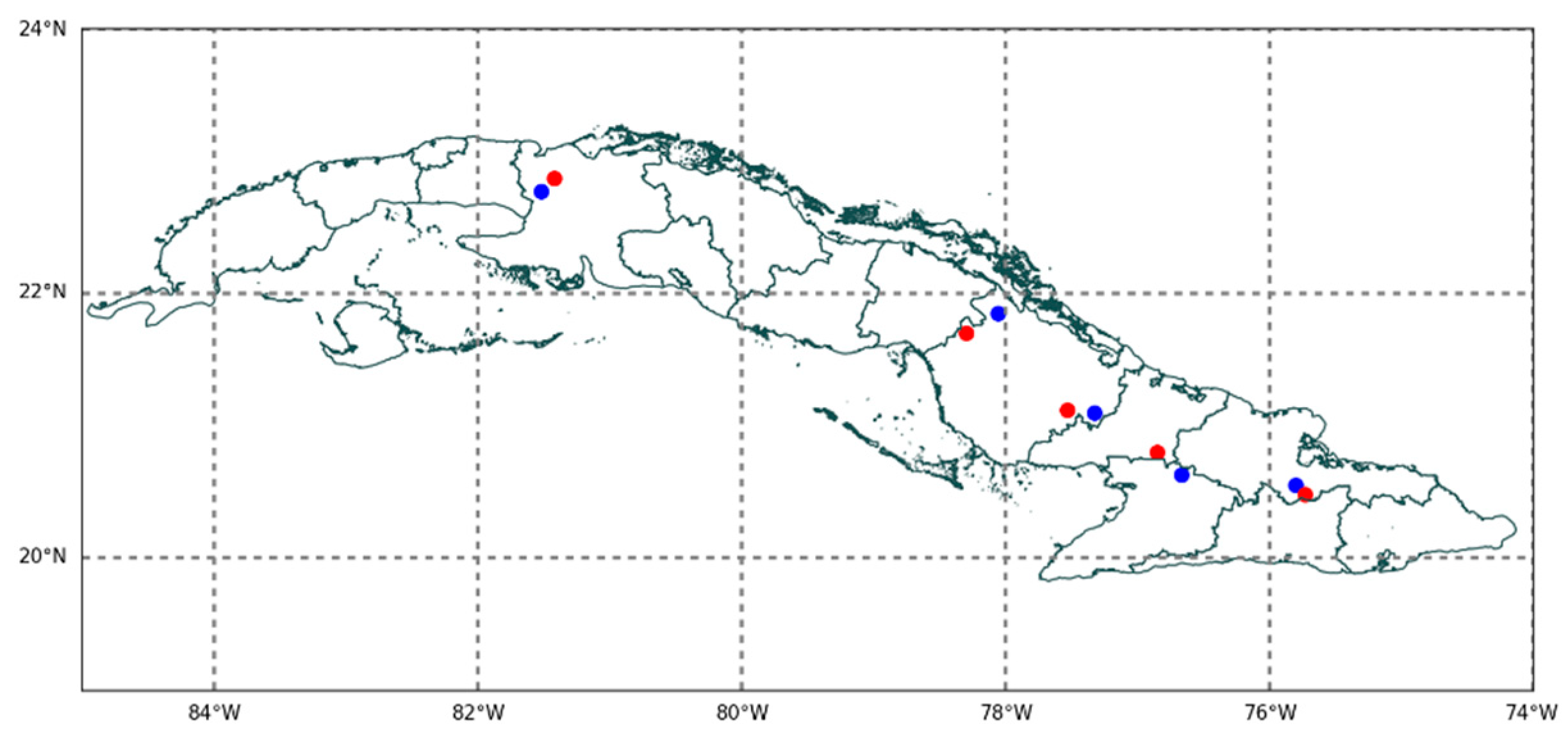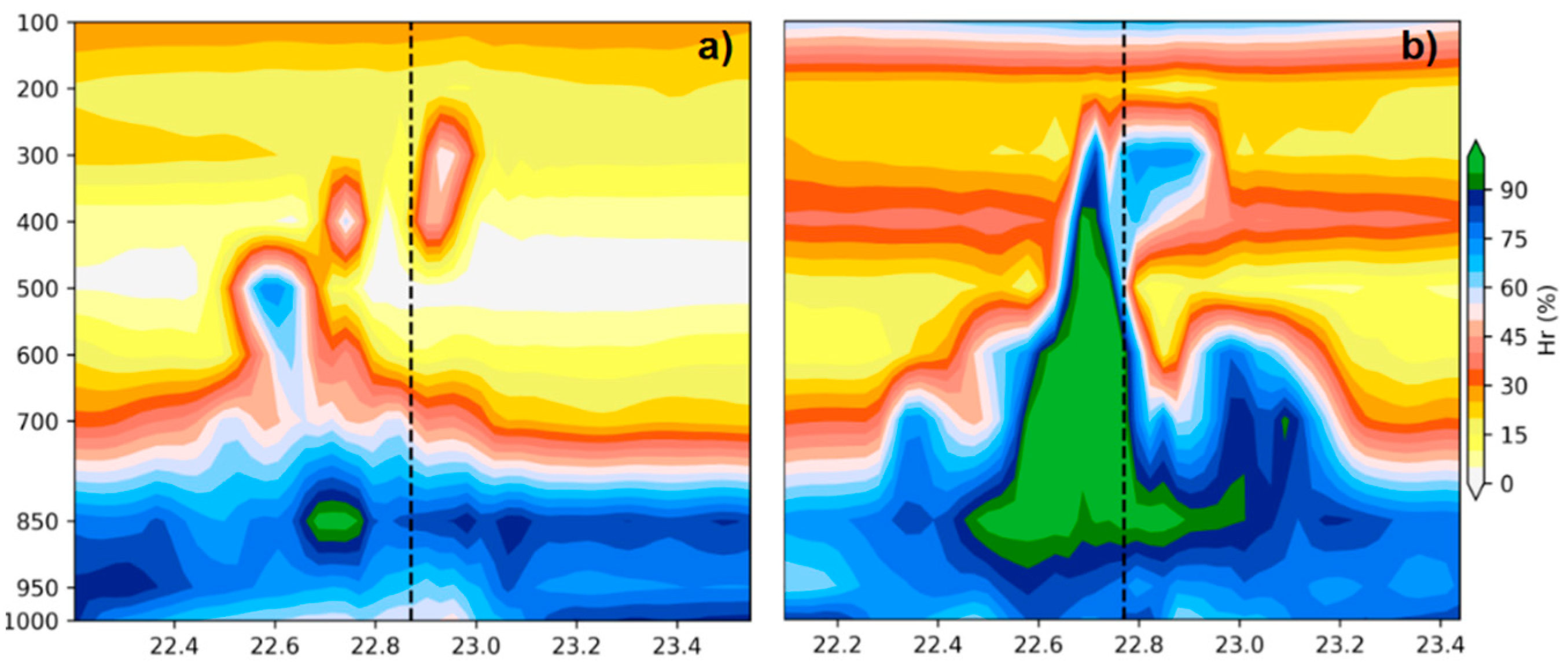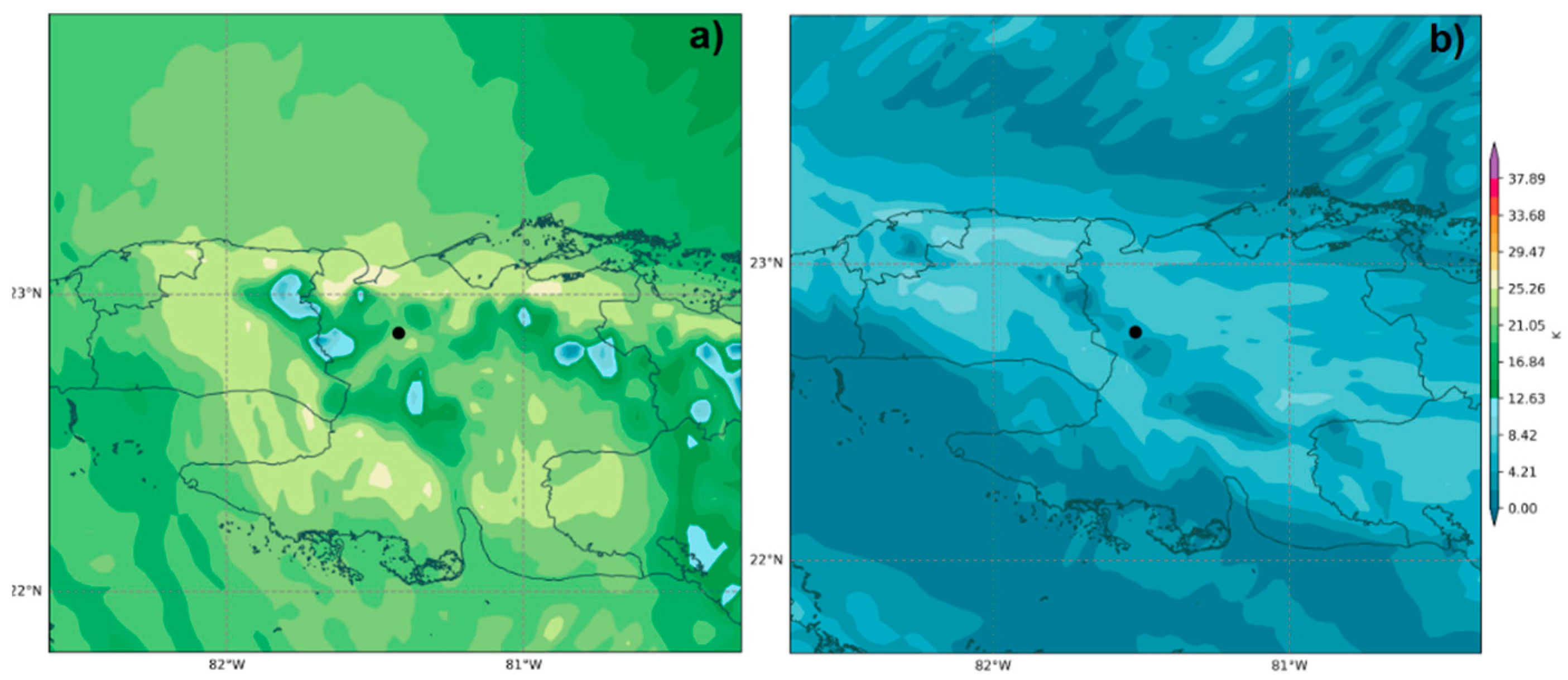Analysis of Possible Physical Factors That Accelerate Downdrafts in Storm Clouds over Cuba †
Abstract
1. Introduction
2. Material and Methods
2.1. Region of Study and Selection of the Cases Analyzed
2.2. Data
2.3. Methodology
3. Results and Discussion
4. Conclusions
Author Contributions
Funding
Institutional Review Board Statement
Informed Consent Statement
Acknowledgments
Conflicts of Interest
References
- Carnesoltas, M.; (Instituto de Meteorología, La Habana, Cuba). Personal communication, 2020.
- Doswell, C.A., III. The Operational Meteorology of Convective Weather. NOAA, Technical Memorandum NWS NSSFC-5. I, NTIS Accession No. PB83-162321. 1982. Available online: http://citeseerx.ist.psu.edu/viewdoc/download?doi=10.1.1.459.9956&rep=rep1&type=pdf (accessed on 15 November 2020).
- Srivastava, R.C. A simple model of evaporatively driven down draft: Application to microburst downdraft. J. Atmos. Sci. 1985, 42, 1004–1023. [Google Scholar] [CrossRef]
- Caracena, F.; Maier, M. Analysis of microburst in the FACE Meteorological Mesonetwork in Southern Florida. Mon. Weather Rev. 1987, 115, 969–985. [Google Scholar] [CrossRef][Green Version]
- Oreskovic, C. Numerical Investigation of Full Scale Thunderstorm Downbursts: A Parametric Study and Comparison to Meteorological Model. Master’s Thesis, The University of Western Ontario, London, ON, Canada, 19 April 2016. Available online: https://ir.lib.uwo.ca/etd/3743 (accessed on 19 December 2020).
- Burlando, M.; Romanic, D.; Boni, G.; Lagasio, M.; Parodi, A. Investigation of the weather conditions during the collapse of the Morandi Bridge in Genoa on 14 august 2018. Nat. Hazards Earth Syst. Sci. 2019. [Google Scholar] [CrossRef]
- Alfonso, A.P. Climatología de las Tormentas Locales Severas de Cuba: Cronología; Editorial Academia: La Habana, Cuba, 1994; 168p, ISBN 978-95-902-0060-1. [Google Scholar]
- Aguilar, G.; Carnesoltas, M.; Naranjo, L.; Balseiro, C. Climatología de las tormentas locales severas en Cuba en el período 1987–2002. Resultados de la modelación de un caso de estudio. Rev. Cuba. Meteorol. 2005, 12, 3–10. [Google Scholar]
- Aguilar, G.; Carnesoltas, M.; Naranjo, L. Condiciones a escala sinóptica favorables para la aparición de tormentas locales severas en Cuba. Período poco lluvioso. Rev. Cuba. Meteorol. 2009, 15, 85–108. [Google Scholar]
- Carnesoltas, M.; Aguilar, G.; Naranjo, L. Condiciones sinópticas favorables para la aparición de tormentas locales severas en Cuba. Período lluvioso. Rev. Cuba. Meteorol. 2010, 16, 13–31. [Google Scholar]
- Carnesoltas, M. Tormentas locales severas. Tres condiciones necesarias. Rev. Cuba. Meteorol. 2019, 25, 90–97. [Google Scholar]
- Gutierrez, M.; Carnesoltas-Calvo, M.; Varela-de la Rosa, A. Factores físicos—Meteorológicos en los niveles medios troposféricos que determinan la ocurrencia de aeroavalanchas en Cuba. Rev. Cuba. Meteorol. 2020, 26, 1–15. [Google Scholar]
- Skamarock, W.; Klemp, J.; Dudhi, J.; Gill, D.; Barker, D.; Duda, M.; Huang, X.-Y.; Wang, W.; Powers, J. A Description of the Advanced Research WRF Version 3; Technical Report; University Corporation for Atmospheric Research: Boulder, CO, USA, 2008; p. 113. [Google Scholar] [CrossRef]
- Stull, R. Practical Meteorology: An Algebra-Based Survey of Atmospheric Science; Department of Earth, Ocean and Atmospheric Sciences, University of British Columbia: Vancouver, BC, Canada, 2015; 939p, ISBN1 978-0-88865-283-6. Available online: http://www.eos.ubc.ca/books/Practical_Meteorology/ (accessed on 20 November 2020)ISBN2 978-0-88865-283-6.
- Atkins, N.T.; Wakimoto, R. Wet microburst activity over the southeastern United States. Implications for forecasting weather. Forecasting 1991, 6, 470–482. [Google Scholar] [CrossRef]




| Parameters | Configuration |
|---|---|
| Spatial resolution | 27, 9, and 3 km |
| Number of points in x | 145, 262, 469 |
| Number of points in y | 82, 130, 184 |
| Vertical levels | 28, 28, 28 |
| Domain center | 21.8° N and −79.74° W |
| Time step | 150 s |
| Microphysics | WSM5, WSM5, Morrison double moment |
| Cumulus | Grell–Freitas, Grell–Freitas, not activated |
| PBL | Mellor–Yamada–Janjic, Mellor–Yamada–Janjic, Mellor–Yamada–Janjic |
| Variable | Formula | Possible Discriminating Factor |
|---|---|---|
| Latent heat | Absorption of latent heat by evaporation and fusion | |
| Equivalent potential temperature | Equivalent potential temperature difference (dry layer in the middle levels of the troposphere) | |
| DCAPE | Dry layer in the middle levels of the troposphere | |
| Buoyancy | Increased buoyancy in the updraft | |
| Precipitable water | Increased water load | |
| Dynamic viscosity | Decrease in viscosity | |
| Kinematic viscosity | Decrease in viscosity | |
| Coriolis vertical component | Coriolis vertical component with an eastern flow | |
| Horizontal advection of energy | Decrease in horizontal advection of energy | |
| Horizontal advection of mass | Decrease in horizontal mass advection |
| Date | Type | ∆QLE (J) | ∆QLF (J) | ∆θeq (K) | B (m/s2) |
|---|---|---|---|---|---|
| 27 April 2017 | DB | 47,766.23 | 6346.72 | 14.73 | 0.1429 |
| 1 July 2017 | DB | 48,338.42 | 6435.03 | 11.99 | 0.1572 |
| 20 July 2017 | DB | 41,797.15 | 5562.41 | 12.19 | 0.1376 |
| 21 November 2017 | DB | 39,596.14 | 5269.84 | 15.05 | 0.1133 |
| 14 May 2017 | DB | 32,799.18 | 4364.37 | 8.99 | 0.1345 |
| 30 April 2017 | TS | 12,749.92 | 1688.76 | 6.30 | 0.0456 |
| 3 July 2017 | TS | 30,537.16 | 4064.28 | 1.68 | 0.1002 |
| 18 July 2017 | TS | 27,030.77 | 3587.75 | 6.48 | 0.0828 |
| 23 November 2017 | TS | 24,607.77 | 3277.13 | 4.62 | 0.0869 |
| 13 May 2019 | TS | 21,510.58 | 2860.20 | 3.08 | 0.0785 |
| Possible critical value | 32,000 | 4200 | 8 | 0.11 |
| Data | Type | Adve (nm) (10−3J/s) | wDCAPE (m/s) | DCAPE (J/kg) |
|---|---|---|---|---|
| 27 April 2017 | DB | 62.50 | 48.62 | 4727.8 |
| 1 July 2017 | DB | 30.34 | 44.65 | 3986.69 |
| 20 July 2017 | DB | 36.77 | 36.33 | 2640.2 |
| 21 November 2017 | DB | 147.19 | 34.52 | 2382.71 |
| 14 May 2017 | DB | 54.96 | 36.18 | 2618.66 |
| 30 April 2017 | TS | 123.86 | 30.22 | 1826.79 |
| 3 July 2017 | TS | 74.17 | 33.19 | 2203.25 |
| 18 July 2017 | TS | 79.59 | 35.97 | 2587.93 |
| 23 November 2017 | TS | 124.28 | 27.82 | 1547.9 |
| 13 May 2019 | TS | 131.09 | 34.47 | 2375.98 |
| Possible critical value | 70 | 36 | 2600 |
Publisher’s Note: MDPI stays neutral with regard to jurisdictional claims in published maps and institutional affiliations. |
© 2021 by the authors. Licensee MDPI, Basel, Switzerland. This article is an open access article distributed under the terms and conditions of the Creative Commons Attribution (CC BY) license (https://creativecommons.org/licenses/by/4.0/).
Share and Cite
Alvarez-Socorro, G.; Carnesoltas-Calvo, M.; Varela-de la Rosa, A.; Fernández-Alvarez, J.C. Analysis of Possible Physical Factors That Accelerate Downdrafts in Storm Clouds over Cuba. Environ. Sci. Proc. 2021, 8, 23. https://doi.org/10.3390/ecas2021-10321
Alvarez-Socorro G, Carnesoltas-Calvo M, Varela-de la Rosa A, Fernández-Alvarez JC. Analysis of Possible Physical Factors That Accelerate Downdrafts in Storm Clouds over Cuba. Environmental Sciences Proceedings. 2021; 8(1):23. https://doi.org/10.3390/ecas2021-10321
Chicago/Turabian StyleAlvarez-Socorro, Gleisis, Mario Carnesoltas-Calvo, Alis Varela-de la Rosa, and José C. Fernández-Alvarez. 2021. "Analysis of Possible Physical Factors That Accelerate Downdrafts in Storm Clouds over Cuba" Environmental Sciences Proceedings 8, no. 1: 23. https://doi.org/10.3390/ecas2021-10321
APA StyleAlvarez-Socorro, G., Carnesoltas-Calvo, M., Varela-de la Rosa, A., & Fernández-Alvarez, J. C. (2021). Analysis of Possible Physical Factors That Accelerate Downdrafts in Storm Clouds over Cuba. Environmental Sciences Proceedings, 8(1), 23. https://doi.org/10.3390/ecas2021-10321







